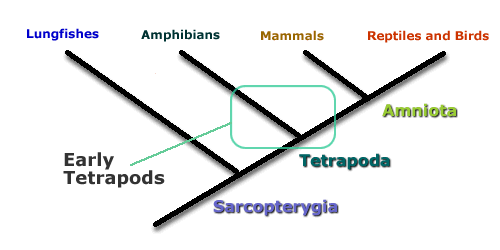



|
|
Tetrapods: Fossil Record
The early tetrapods were the first vertebrates to truly walk the land. Before tetrapods existed, vertebrates were all confined to living in aquatic habitats. The tetrapods began their conquest of land in the Paleozoic around 360 million years ago. Tetrapods are a name that we have given to anything with four feet (tetra=four, pod=feet). Therefore all land dwelling vertebrates can be considered tetrapods. However, when discussing the EARLY tetrapods, we are usually discussing very primitive groups that have none of the specializations of their living descendants: amphibians, mammals, and reptiles (including birds). Dendrerpeton, a common fossil of Joggins, Nova Scotia, is an example of an early tetrapod. Tetrapods, whose closest living relatives are lungfish, have two main groups: amphibians and amniotes. The amniotes in turn have two main groups: the synapsids (including mammals) and the sauropsids (including reptiles and their fossil relatives).



|
